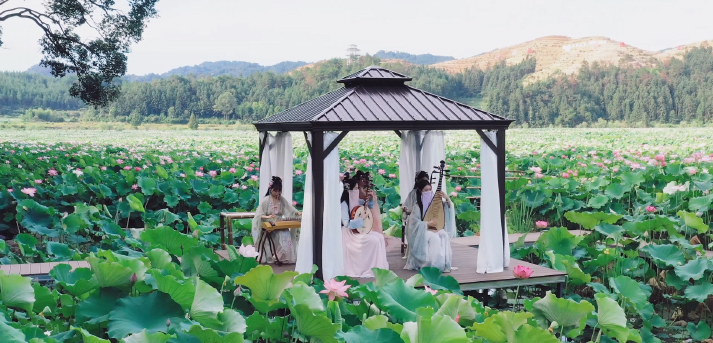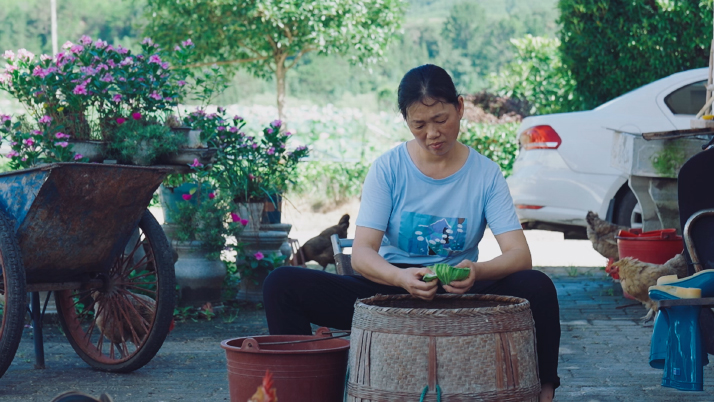Throughout every summer season, the ponds and lakes of Yaoxi Village in Guangchang County, located in east China’s Jiangxi Province, transform into vast expanses of lotus flowers, drawing tourists with their enchanting beauty.
Chinese people harbor a deep affection for the lotus flower. Although it emerges from the murky depths of the mud, the lotus flower maintains its pristine cleanliness and transforms into something exquisite. It is therefore a timeless symbol of beauty, purity and spiritual enlightenment.
In Guangchang, people consider the flower to be an integral part of their traditions and daily lives. Blessed with the ideal geography and climate for lotuses, locals began cultivating these plants 1,300 years ago. In 2016, Guinness World Records confirmed that the county had set a remarkable new record as the home of the world’s largest lotus field.
Today, the county is renowned as the “hometown of white lotus in China,” with the growing area now more than 73 hectares. It yields an annual output of 9,000 tons of dried lotus seeds, which are used in East Asian cuisine, creating an output value of more than 800 million yuan ($110 million). Also, the county is home to China’s largest center for white lotus research, production and distribution.

A space-bred variety
The success of Guangchang’s lotus industry can be traced back to 1994, when Liu Guangliang, then head of the county’s white lotus research institute, heard about China’s experiments taking seeds into space. The higher radiation and unique environment of space increases the rate of mutation in seeds, accelerating production of new varieties from which scientists can select for favorable characteristics.
With the support of the local government, 442 seeds from over 10 lotus varieties grown in Guangchang were sent into space for 14 days before being returned to the institute.
After five years of cultivation by the institute, a new variety known as No.36 space-bred lotus outperformed traditional varieties. It boasts an extended growth period, abundant flowers and large lotus pods of superior quality.
In that same year of 1999, the county began to trial commercial growing of the No.36 space-bred lotus and 20 bases were established to grow the variety. However, lotus farmers, who were accustomed to traditional varieties, showed little interest in the new one. With encouragement from lotus technicians from the institute, Xie Changjun, a resident of Xialan Village in Guangchang, decided to take the lead by planting 4 mu ( 0.27 hectares) of the space lotus.
He was surprised by the results. “First, the bloom is unique. Flowers of traditional varieties are beneath the leaves while flowers of the new one stretch out above the leaves, creating a sea of blossoms in the distance,” Xie told Xinhua News Agency in March.
His success made a stir in the village, and people lined up to purchase his seedlings. Xialan currently has 502 households, with over 240 engaged in lotus farming.
Since then, the No.36 space-bred lotus has been introduced to lotus production areas across China.
In 2019, Guangchang established what it calls a white lotus science and technology research “courtyard” with the aim of upgrading its white lotus industry.
The county has over 20 enterprises dedicated to the development and processing of white lotus products, boasting a range of nearly 150 items. These include dried white lotus seeds, lotus root powder, medicinal products and white lotus seed processing machinery.

Lotus plus
The white lotus seeds from Guangchang are renowned for their exquisite white color, generous size, delightful sweetness, refreshing fragrance, abundant nutrition and a wide range of medicinal benefits.
“Nearly every household in our village is engaged in related businesses,” Feng Guangrong, Secretary of the Yaoxi Village Branch of the Communist Party of China, told Beijing Review. He added that their work, which includes lotus picking and seed processing, begins at 5 a.m. and finishes at 8 a.m., then resumes from 5 p.m. to 7 p.m.
“When I was a student, I used to assist my family in managing these seeds during the summer and winter vacations. The income from this work helped cover my expenses for the next semester,” Feng said.
Feng said that when the lotus pods develop black spots, it indicates that the seeds are ripe and ready to be harvested. Additionally, medium-ripe lotus seeds, which are less ripe than the normal ones, are also available for picking, as they have recently become favored by consumers due to their fruity flavor.
Yaoxi is one of the main lotus production areas in Guangchang, and has a growing area of about 133 hectares. In 2022, Yaoxi established a factory to produce lotus seed products.
This new facility utilizes machines to peel, shell and dry raw lotus seeds, resulting in a significant increase in productivity. As a result of these improvements, the factory is now able to produce nearly 2,000 kg of lotus seeds daily. According to Feng, the village’s income surged from 168,000 yuan ($23,537) in 2020 to nearly 560,000 yuan ($78,456) in 2022.
While machines are now capable of handling some aspects of lotus seed processing, the traditional eight manual steps to process lotus seeds have been preserved as a cultural heritage, Feng explained.
After picking lotus pods, the seeds are removed and their shells opened before being soaked in water. The next step involves splitting the seed and removing the seed plumules (embryos), and rinsing the seeds before drying them, which gives them a nutty aroma. “We value and uphold this tradition as we have a great love for our white lotus and aim to promote our rich lotus culture,” he said.
As the lotus industry has thrived in recent years, Guangchang has been focusing on developing tourism centered on lotus flowers. The county offers a variety of tourist-friendly activities such as flower appreciation, fruit tasting and entertainment. For those seeking an enchanting experience, the annual Lotus Tourism and Culture Festival in July is a must-visit event.
From January to May 2024, the county welcomed 3.35 million tourist visits, generating about 2.1 billion yuan ($289 million) in tourism revenue. –The Daily Mail-Beijing Review news exchange item





